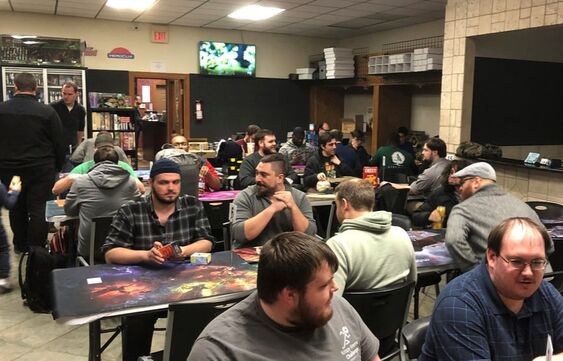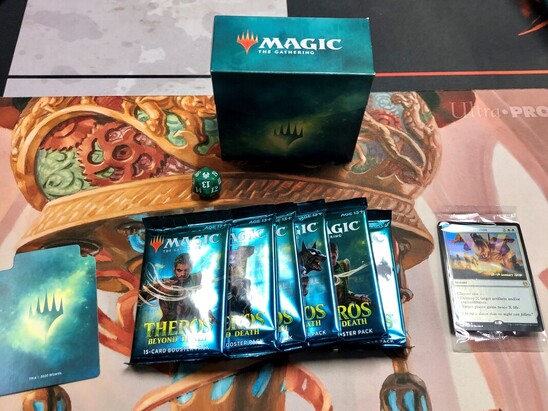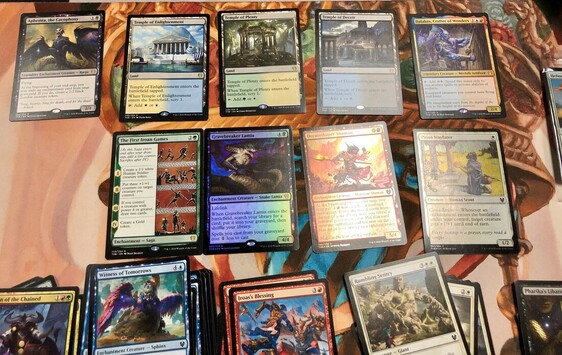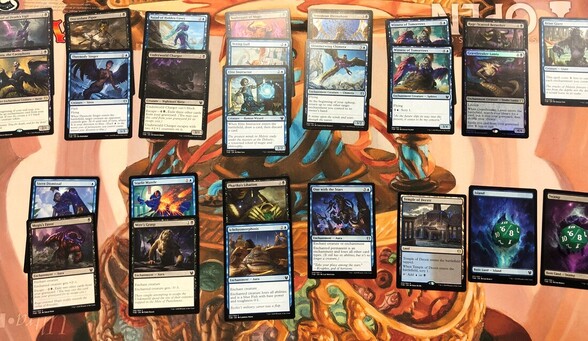|
New sets in the Magic: The Gathering trading card game are released periodically throughout the year. Each quarter, large sets are released for the Standard format. New Standard sets are introduced in-person to players through prerelease events. A typical prerelease event occurs the weekend before a set's official release date. These weekends are exciting to players as it is the first opportunity to acquire brand new trading cards. Players participate in the Sealed and Two-Headed Giant formats during a prerelease weekend. What Players Receive at a Prerelease Event When a player registers for a prerelease event, they pay money to receive a sealed kit for the newest MTG set. This kit contains six booster packs, one promotional card, one spindown life counter, and an insert. Other special items could be included in the sealed kit depending on the featured set. Players are given around 50 minutes to open the contents of a kit and build a 40 (or more) card deck. A built deck can only contain the promo card and other cards opened in booster packs found inside the kit. The only exception is that decks can contain any quantity of basic lands. Stores provide basic lands for players to borrow during a prerelease. There is a bit of luck and variance involved as some cards in the set are more powerful than others. The Basics for Building a Deck Building a deck can be challenging for new players or those unfamiliar with a set's mechanics. Other players and staff at the event will typically help newer players who ask for assistance. In general, a sealed deck contains 17 lands, 15 creatures, and 8 spells. These numbers can fluctuate depending on how a deck is built. For example, the pictured deck below contains 17 lands, 16 creatures, and 7 spells. There are multiple strategies involved in building a deck from a limited pool of cards. One basic strategy is building around the most powerful cards opened. The most powerful cards are usually found at mythic and rare. Uncommon and common cards compliment many of the mythic and rare cards centered around particular mechanics. Multicolored cards at uncommon often act as guideposts for a set's themes and mechanics. In addition, non-basic lands that produce two colors of mana are used in preferred color combinations. It is important to have creatures and spells at different mana costs. A good rule of thumb is to have seven to nine creatures with mana costs between one and three. This allows the deck to potentially cast a creature on each turn. Creatures and spells with mana costs between five and seven should be limited in quantity. Having one or two cards between six and seven mana is typically enough in an average deck. Once a player has determined which cards to use in a deck, they need to decide the quantity for basic lands in each color. Sealed decks typically contain two colors. A common method to calculate a land ratio is to count the mana symbols on each card. Compare the results and use those numbers to determine basic land counts. For example, the deck below contains 11 black mana and 13 blue mana symbols. Since a dual color land was available in the pool, the remaining basic land slots were split evenly. Otherwise, the deck would likely contain 8 swamps and 9 islands. If a deck contains multiple cards with two of the same color mana in the casting cost, consider running more of that color's basic land. When splashing a third color in a sealed deck, ensure there are at least three sources of mana generation to cast one mana symbol of that color. Beyond basic lands, a source can be a creature that produces other colored mana or a spell that finds a basic land in the deck. It is recommended not to add a card containing two splash color symbols in its casting cost. Playing Against Opponents
A prerelease event usually consists of three rounds against different opponents. When deck building is complete, players are randomly assigned an opponent for the first round. A player wins a round by defeating their opponent in two out of three games. A draw can occur if time is called and each player has won zero or one game. In Two-Headed Giant, players only play one game per round. Pairings for the next two rounds are assigned based on a win-loss record. Booster packs are awarded as prizes when the event ends. Players receive a quantity of prize packs based on their overall win-loss record. Prereleases are a fun way to experience a new MTG set. They offer a casual environment for new and veteran players to compete in a Limited format. Many players believe prerelease events are the most exciting MTG event offered throughout the year. Prerelease events are something a MTG player at any skill level can participate in and enjoy. Comments are closed.
|
Follow me
on Instagram @card_knock_life Categories
All
Archives
July 2024
This website contains affiliate links
|




 RSS Feed
RSS Feed
